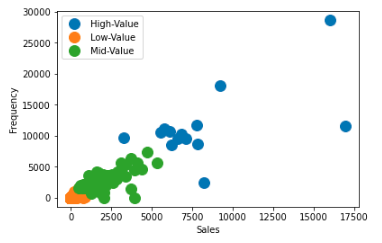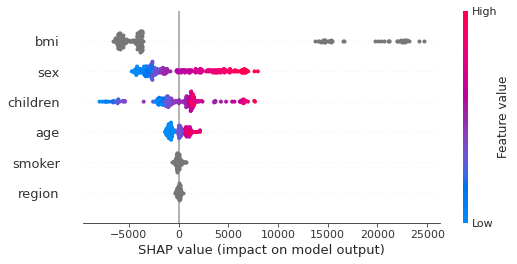Sample Portfolio
01100001 01101101 01100100 01100111
Ernesto L. Garcia C., PhD.
“Experienced practitioner able to understand the challenge and business context, choose the right technology and deliver solutions leading teams, being part of a team, or individually. Engineer with mastery of statistics and linear algebra to approach problems with rigor and mathematical superiority; Machine Learning technologies to achieve modeling performance; Analytics acumen to focus on the important rather than the interesting; and Storytelling to translate complex results into practical decisions.”
You can reach me at: gauchecolibri@gmail.com
1. Market Segmentation using RFM and Cluster Analysis
(Topics: Data Science, Marketing)
Situation: The marketing function of a company wanted to perform a customer segmentation of its customers using a RFM algorithm. The data (reduced, scaled and transformed to provide anonymity) consists of 594,783 purchasing entries with three columns: Date, Client, and Sale value.
Definitions:
- Customer segmentation is the process of dividing a market into sub-groups of clients based on some type of shared characteristics.
- RFM stands for Recency, Frequency, and Monetary value (Sales in this example).
Objective: Segment clients based on when their last purchase was (Recency), how often they’ve purchased in the past (Frequency), and how much they’ve spent overall (Sales). In general, these measures are effective predictors of a customer’s willingness to engage in marketing messages and offers.
Task: Machine learning clustering algorithms were used to group similar objects into respective categories.
Output: Once these groups were clearly defined, a marketing team could target clients within each classification using specific strategies to increase profits.

 —
—
2. A3 and TBP for Process Improvement
(Topics: Lean-Six Sigma, Logistics, Sustainable defect reduction)
Situation This is a short paper describing the use of the A3/TBP methodology in a real case that delivered dramatic results.
Objective: Comunicate that any transformational project needs to be explored and observed in the “place where the action is.” The term for exploring and observing a process is called Genchi Genbutsu.
- Caveat: Through each step of the A3 methodology I have used baseball quotes. When I sent the first draft for feedback some of my colleagues from overseas replied that they were not able to understand the quotes due to their lack of familiarity with baseball. A future case, with soccer references :), is on the way.
Tasks: Eight steps for Toyota’s A3.
Output: Zero defects in a record number of shipments.
3. Classifiers improving human appraisers evaluation
(Topic: Machine learning simple algorithms)
Situation: Four classification algorithms were tested on a generic mines classification problem (see reference in Github repository)
Objective: Provide better performance than human inspectors in the detection of submarine mines.
- Baseline: Three trained human subjects detected 88% to 97% of the mines. However, they may have been using information from the raw sonar signal that is not preserved in the processed data sets presented here.
Output: One of the models detected 98.1% of the mines at higher speed and lower cost.
4. Overland Move Planning for Intermodal Logistics with Order Uncertainty
(Topics: Operations Research, Logistics)
Situation: as part of the selection process for an ERP system in transportation of cargo, a team of engineers from academia and industry was tasked to estimate the feasibility of a model to eliminate the transportation of empty containers under conditions of uncertainty.
Objective: Describing the mathematical model and systems architecture to minimize the transportation of empty containers for a logistics company.
- Paper presented at ISERC 2013, Puerto Rico.
Output: Proof of concept for future selection of best commercial solution.
- This proof of concept was developed with faculty and PhD students from the University of Florida.
5. Operating profit maximization for Ship Assist & Escort
(Topics: Marketing/Sales, Mix Modeling and Optimization, Simulation, Random Forest Regression, Maritime ship assist)
Situation: Create a model to optimize the portfolio of clients under contract to maximize operating profits for a ship assist operation.
Objective: Increase the operating profit of a Ship Assist & Escort company in the West coast.
- Presented at the 2020 Lean & Six Sigma World Conference.
Tasks performed: Exploratory data analysis, analysis of data using regression trees that led to determination of arrival and process distributions, model logic structure, activities and resources for discrete event modeling using Arena. After the model was created and validated, evaluation of potential scenarios was carried on to select the best operating portfolio.
Output: Portfolio Mix with a positive shift of 11 percent in operating margin.
- This project was jointly developed with one heck of a good industrial engineer: Mr. Rami Mouad.
6. Forecasting Health Insurance Costs
(Topics: Machine learning, Health Insurance)*
Situation: Different regression models and techniques are used to estimate health insurance costs in a generic data set.
Objective: Develop a simple but robust model to estimate the cost of health insurance as a function of variables considered under control of the individual.
Tasks: Different approaches were evaluated and are in the repository: Multiple Linear Regression, Random Forests, Boosting (CatBoost), Hyperparameter Optimization (random search, grid search), and Polynomial Regression.
Output: Two models: A Random Forest Tree with Hyperparameter Optimization using random search and a Random Forest with Boosting (CatBoost) with grid search provided the best predictability with R2=0.87 on test data.
7. Paper on Binary Classification Metrics
(Topic: Machine learning)
Description: Basic performance measures for classification models are presented along with general selection guidelines and a discussion of the costs associated to a bad prediction. Reading time: 15 minutes.
8. Samples of material used for training
(Topics: Training material on OEE, Capability)
Description: These are samples of training materials used by my customers. They can be supplemented with real examples from your operations. Go to the link and feel free to download the files.
9. Matching Mentor and Mentee for a leadership program
(Topic: Operations research in R)
Situation: The leadership development group requested an algorithm to pair mentees with mentors based on their preferences. These mentees were part of a leadership program that included training, job rotation and mentorship for six months.
Objective: The program manager wanted to have the matching pairs defined within one hour of generating preference submission forms for all mentees. This was done during the kick-off of the program. Therefore, the analyst had to receive the preferences by e-mail and submit a matching list to the manager within 60 minutes.
Tasks: Forms were developed in excel as well as a function in R that provided a stable “marriage” algorithm using as input the names of the mentors (called Yodas), mentees (called Padawans) and a matrix establishing the preferences of each mentee. For this case the mentors have no specific mentee preference.
Results: The algorithm was run and provided a stable matching. A list of the mentee-mentor names was supplied to the manager within 60 minutes of the reception of all data.

10.Fuel Supply for the State of Florida During Hurricane Evacuation
(Topic: Six Sigma, Monte Carlo Simulation, Forecasting, Analysis)
Situation: Preparedness for Hurricane during 2018.
Objective: Provide the Florida Department of Transportation (FDOT) with fact-based recommendations to improve the State’s rack-to-retail fuel capacity in the context of a hurricane evacuation leveraging existing infrastructure and commercial fuel industry capabilities.
Tasks: An analysis of supply and demand of gasoline fuel during the previous 5 days to hurricane arrival was performed using regression, montecarlo simulation and statistical analysis –distribution fitting. The study included quantification of the number of gas trucks needed by day and hour.
Results: This is a brief summary of the recommendations provided.





